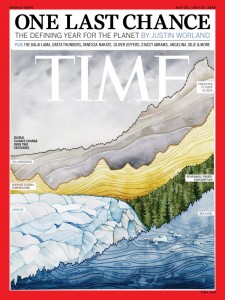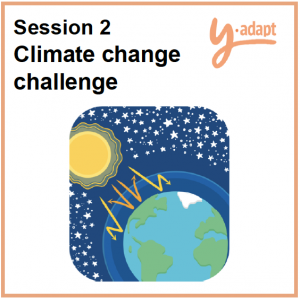From an Article by Justin Worland, TIME — America Must Change, July 9, 2020
We are on the brink of climate catastrophe largely because of the decisions made during a past crisis. As the world came out of the Great Depression and World War II, the U.S. launched a rapid bid to remake the global economy – using fossil fuels.
In the first postwar years, Americans moved to suburbs and began driving gas-guzzling cars to work, while the federal government built a highway system to connect the country for those vehicles. The single biggest line item in the Marshall Plan, the U.S. government program that funded the European recovery, went to support oil, which ensured that the continent’s economy would also run on that fossil fuel. Meanwhile, plastic, an oil derivative, became the go-to building block for consumer goods after the U.S. had developed production capacity for use in World War II.
The underlying philosophy of economic development in this time period was a focus on gross national product, a term developed by U.S. government economists during the Depression, which included consumption as a proxy for prosperity: the more we consume, the better off we are, according to this model, which, in the postwar era, the U.S. assiduously spread abroad. The promise of endless growth also required an endless supply of oil to power factories, automobiles and jet planes. In 1945, President Franklin D. Roosevelt sealed a deal with Ibn Saud, the first King of Saudi Arabia, trading security for access to the country’s vast oil reserves. Every U.S. President since, implicitly or explicitly, has continued that exchange.
The coronavirus pandemic is the most significant disruption yet to the postwar fossil-fuel order. The global economy is expected to contract more than 5% this year, according to the International Monetary Fund (IMF). This is a challenge so big that it has also created a once-in-a-lifetime opportunity to change direction.
This moment comes just in time. In 2018, a landmark report from the Intergovernmental Panel on Climate Change, the U.N.’s climate-science body, warned that allowing the planet to warm any more than 2°C above preindustrial levels would drive hundreds of millions of people into poverty, destroy coral reefs and leave some countries unable to adapt.
A 2019 analysis in the journal Nature identified nine tipping points–from the collapse of the West Antarctic ice sheet to the thawing of Arctic permafrost–that the planet appears close to reaching, any one of which might very well be triggered if warming exceeds 1.5°C. “Going beyond 2°C is a very critical step,” says Johan Rockstrom, director of the Potsdam Institute for Climate Impact Research, “not only in terms of economic and human impact but also in terms of the stability of the earth.”
To keep temperatures from rising past the 1.5°C goal, we would need to cut global greenhouse-gas emissions 7.6% every year for the next decade, according to a report from the U.N. Environment Programme (UNEP). That’s about the level the COVID-19 pandemic will reduce emissions this year, but virtually no one thinks a deadly pandemic and accompanying unemployment is a sustainable way to halt climate change–and recessions are typically followed by sharp rebounds in emissions.To achieve the 1.5°C goal without creating mass disruption has always meant thoughtfully restructuring the global economy, moving it away from fossil-fuel extraction slowly but surely. Scientists and economists agree this is the last opportunity we have to do so. “If we delay further than 2020,” says Rockstrom, “there’s absolutely no empirical evidence that it can be done in an orderly way.”
As of late June, countries had spent some $11 trillion on measures to halt the pandemic and stem its economic impact, according to the IMF. Economists say that’s not enough, and countries and central banks plan to keep doling out money to help the global economy stay afloat. There are lots of things we could be buying with that money that would make our lives better and protect us from climate disaster. In recent months, leading institutions across the spectrum have offered approaches that are varied in their specifics but generally similar in philosophy: invest in greener infrastructure.
The International Energy Agency (IEA), for example, calls for an annual $1 trillion investment in clean energy for the next three years. At a cost of about 0.7% of global GDP, this would represent a small portion of the funds spent to combat COVID-19 but could be transformative. Expansion and modernization of electric grids would allow for easier flow of renewable energy. Governments could buy out gas-guzzling vehicles, pushing consumers to go electric. Homes and buildings could be retrofitted to consume less energy.
This spending would also help solve the immediate problem of lost jobs and economic stagnation by creating nearly 10 million jobs worldwide and increasing global GDP by 1.1%, meaning it would add more to the economy than it costs. Importantly, green investment would result in a slew of “co-benefits.” For example, some rural communities would receive access to electricity for the first time. For another, air pollution would decline all over the world. “If governments do not make use of this opportunity, they may miss a very important tool for the economic recovery,” says Fatih Birol, head of the IEA.
But this moment is not just about opportunity; even maintaining the status quo is dangerous. Research from the UNEP released last year shows that if nations stick with current plans to reduce emissions, global temperatures will rise more than 3°C by the end of this century.
Please see this Article in Time Magazine or Part 3 tomorrow!
>>>>>>>>>>>>>>>>>>>>>>>>>>>>
‘Y-ADAPT’ or ‘Youth Adapt’ is an innovative curriculum using a games-based approach to engage and inspire 13 – 25-year-old youth, to develop and implement their own climate change adaptation action and advocacy plans in their local communities.


